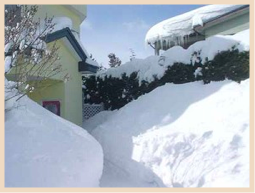
Todd Jay Leonard, Blog


The prefecture where I live in Japan is located at the northernmost tip of the main island of Honshu. This region of the country is notorious for its incredible winters and huge snow accumulations.
This winter has been especially harsh, because the snow began to fall in mid-December and has not abated since. It is not at all uncommon to get a foot of snow in one day. In one 24-hour period, we received nearly a yard of snow.
It seems unbelievable, but it is just a fact of life here in “snow country.” Each morning, everyone gets out and shovels the snow in front of their homes, piling it in every available space in the yard and around the house.
“Yuki kaki” or “snow removal” is the obligation of homeowners. There are no sidewalks, so often homes are built nearly on the street. Everyone clears away the snow from in front of their own home, which is basically the public street.
My particular street is much too narrow to have a snowplow come down, so it is up to us to get out early and shovel away the snow before people begin to go to work and children walk to school.
Most cars here have front-wheel drive, and no one seems at all bothered by the snow, plowing through as if it wasn’t there. A fraction of this amount of snow would bring most cities in the U.S. to a complete standstill.
American school children will be disappointed to hear that there is no concept of “snow days” here where school is canceled. In fact, in all the years I have lived here, I have never heard of anything being canceled due to snow, with the exception of some flights and trains because of drifting snow.
School is held regardless ,because there is no school bussing system here like in the United States; students must walk, take public transportation, or be driven by a parent each day to school.
One interesting sight during the winter season is seeing old men determined to ride their bikes on packed snow and ice — no matter what. They ride, teeter-tottering along the road, doing whatever they can to keep the bike from slipping out from under them. Where they are going, I have no idea, but it is amazing that they even attempt such an outing.
So far this year, a number of people have died due to the snow, mostly being buried alive from trying to remove the snow off the roofs of their homes. One woman was killed when she fell into a creek; she was pushing snow from near her home into the waterway when she lost her footing and fell in.
A number of children perish each year when it begins to warm up, which causes huge chunks of snow to avalanche off the roofs of homes onto where they are playing below. Japanese parents do their best to warn children not to play below the roofs, but kids will be kids.
Also, sometimes roofs cave in due to the weight of the snow, covering those inside with a mixture of snow and rubble.
My roof has small “snow stoppers” every so many feet to keep the snow from sliding off in one huge chunk. It makes it safer for those on the ground, but means the weight of the snow stays on the roof.
The extreme weight of the snow makes it very dangerous for older homes. Already a number of homes have been damaged and even completely destroyed by the weight of the snow.
It is common practice here to hire snow-removal people to climb onto the roof to push off the accumulated snow. I had a difficult time finding someone to do it this year. They are all booked solid for weeks because so many homes are in need of being cleared of snow.
Already this year, one prefecture has had to have the Self Defense Forces assist residents in a mountain village to get the snow off of their roofs. The news showed one house literally buried. When they finally got the front door dug out, a very grateful old man came out to thank them.
Last year, while I was away on sabbatical at the University of Wisconsin-La Crosse, the snow was so heavy on my roof that the upstairs’ bedroom doors were wedged shut. Not knowing how serious the situation was because I wasn’t there, the beams in my attic buckled causing cracks to form in the plasterboard on my walls, due to the weight of the snow.
Luckily, I had recently had my home earthquake-proofed, which gave it extra strength, but it was still damaged nonetheless. So, I am quite aware of how much snow is on my roof at any one time, and I tend to get it cleared off before it gets to be a yard or so high after settling.
A neighbor two doors down has snow up past the first floor of the house. Every November, they put slats of wood across the windows so when the snow starts to pile up the pressure from the snow doesn’t break through into the house itself. They have just enough space to get in and out of the house through the front door.
It all seems so dreadful, I know, but I actually don’t mind the snowy weather. It keeps me active, giving me plenty of daily exercise and frequent opportunities to talk to my neighbors. It certainly is a communal effort to keep the snow at bay.
By TODD JAY LEONARD
Columnist
Japan’s snow is deep, dangerous
Monday, February 27, 2006







